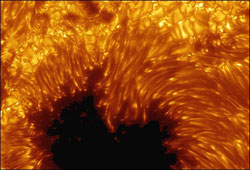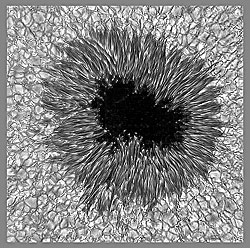
Sun-Earth Day 2007 presents: Living in the Atmosphere of the Sun
Spots on the sun were once seen as rare and exotic, but are now a commonplace, solar event.
ISSUE #52: SUNSPOTS FROM A TO B - SOLAR MAGNETISM

Figure 1: Closeup of a sunspot taken with the Swedish Solar Telescope in La Palma, the Cannary Islands. ( Courtesy: Göran B. Scharmer, and Boris V. Gudiksen, The Swedish Institute for Solar Physics)
Sunspots have been observed on the sun for thousands of years, but only during the last century have astronomers figured out what they actually are, and why the sun has them! Most of this advancement in our knowledge occurred because of the advent of new technologies to observe the sun since the 1850s. Another important clue to solving the sunspot mystery was revealed when scientists developed powerful new insights about how matter and the various fundamental forces of nature, actually worked.
Sunspots are found in the photosphere of the sun, where the temperature is 6,000 C, and the surface is covered by innumerable, small convection cells called 'granules' (Figure 1). Sunspots have a dark, central region called the umbra, surrounded by a lighter region called the penumbra. When examined at high resolution, the penumbral region resolves into numerous filaments or 'fibrils' that radiate outwards from the dark umbral zone (Figure 2). Temperatures in the umbral zone are commonly about 2,200 C, while in the penumbral zone, temperatures can be as high as 3,500 C. The reason that sunspots appear dark is that they are as much as 3,000 C cooler than the rest of the solar surface! Because brightness depends on the fourth-power of the temperature, the sunspot umbra emits 1/6 as much light as a similar-sized piece of the solar surface.

Figure 2: Sunspot AR 10810, observed Sept. 23, 2005 with the Dunn Solar Telescope at the NSO. At this scale, the Earth is as big as the dark 'umbral' region. (Courtesy: Friedrich Woeger, KIS, and Chris Berst and Mark Komsa, NSO/AURA/NSF.)
Sunspots can be so cold that water vapor 'steam' can even form within them! In 1995, astronomers Lloyd Wallace, William Livingston and Kenneth Hinkle at the National Solar Observatory in Tucson, Arizona worked with collaborators to obtain infrared spectra that proved that water molecules could exist in the umbral regions of some sunspots.
There is no typical size to a sunspot. They can be as small as the continent of Africa, or as large as 30-times the diameter of the Earth! The number of sunspots on the solar surface also varies in an 11-year cycle, discovered in 1843 by German astronomer Samuel Heinrich. During the peak of the sunspot cycle, as many as 200 spots and sunspot groups can be found. In actuality, the sunspot cycle is 22-years long because of the magnetic properties of the sun.

The sunspot cycle during the last 400 years.
Sunspots would not exist were it not for solar magnetism.
Below the photosphere, the convecting upper region of the sun allows the solar magnetic field to be concentrated into dense rope-like structures. These magnetic ropes become buoyant and float up to the surface, where they erupt as a pair of sunspots; one with a north-type polarity and one with a south-type. At the start of the first cycle, the leading sunspot has the same polarity as the magnetic field of the sun in that hemisphere. When the next 11-year cycle starts, the leading sunspot has the opposite polarity. Then during the third cycle, the polarity of the leading sunspot has returned to the same polarity as the solar field in that hemisphere. The full 'Hale-Cycle' takes 22 years.
The magnetic properties of sunspots were discovered by astronomer George Ellery Hale (1868-1938), in 1908 using a new instrument he had invented, and a newly-discovered physical effect called Zeeman splitting. Under laboratory conditions, if you look at the light from atoms in a strong magnetic field, a very high resolution spectroscope will show that the atomic lines are split into pairs. The wavelength separation of these pairs will increase as the strength of the magnetic field increases. After careful measurements, Hale was able to determine that sunspots have magnetic fields as strong as 1,500 Gauss, which is about 2000 times Earth's magnetic field, and 100 times the Sun's common surface field!
The discovery of strong sunspot fields also provided astronomers with a powerful clue as to why they are dark. The strong magnetic field of a spot makes it very hard for gases below these spots to transport heat from the lower layers of the sun to its surface. That means that the gases can be considerably cooler than the rest of the sun because there is less energy available from below to keep them heated. As a result, the gases are cooler, emit less light, and are darker.
Recently, data obtained by the SOHO satellite has allowed astronomers to look below the surface of a sunspot! The accompanying animation, based on a computer model of the physical conditions, reveals just how gases move around. (SOHOconv.mpeg). As the cooler umbral gasses flow downwards, they collide with upward-moving gases, and are deflected around the spot.
An important consequence of this flow pattern is that the energy flowing from lower regions is diverted around the sunspot and causes the surrounding solar surface to emit more ultraviolet light. As a result, during sunspot maximum conditions, the sun is actually a few percent BRIGHTER in ultraviolet light than at other times, even though the surface is visibly covered with lots of dark umbral regions. This UV increase can be detected at Earth, and actually produces a measurable climate impact!
By the way, high-resolution images of sunspots reveal new details that challenge astronomers to understand even finer details of sunspot physics. In Figure 1, taken with the Swedish Vacuum Telescope at La Palma in the Canary Islands, features described as hairs and canals are seen as dark cores visible within the bright filaments that extend into the sunspot. The filaments' newly revealed dark cores are seen to be thousands of kilometers long but only about 100 kilometers wide. These features represent previously unknown and unexplored solar phenomena.
Stay Tuned!!!
An animation based on a computer model of the physical conditions, reveals just how gases move around.
The latest Flash player plug-in is required to view this movie.
Technology Through Time
2007 ISSUES
- #57: The Heliosphere
- #56: Coronal Mass Ejections
- #55: Solar Corona, Holes and Wind
- #54: Solar Flares... Oh my!
- #53: Solar Prominences
- #52: Sunspots from A to B - solar magnetism
- #51: The Transit of Mercury
- #50: Ancient Sunlight
- #49: Solar Energy
- #48: The Sun: From Cradle to Grave
View past issues
Authors and Designers
Space Weather Fact
The largest, single, challenge for astronauts traveling to Mars will be to overcome exposure to solar storms and radiation.


